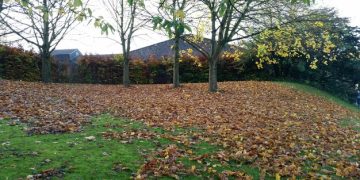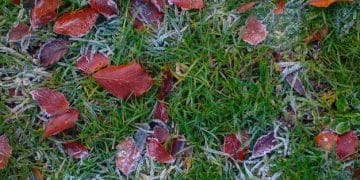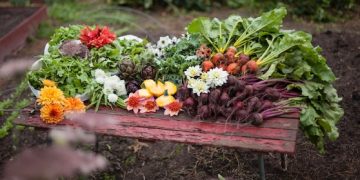Improve Soil Drainage: Simple Solutions for Soggy Gardens
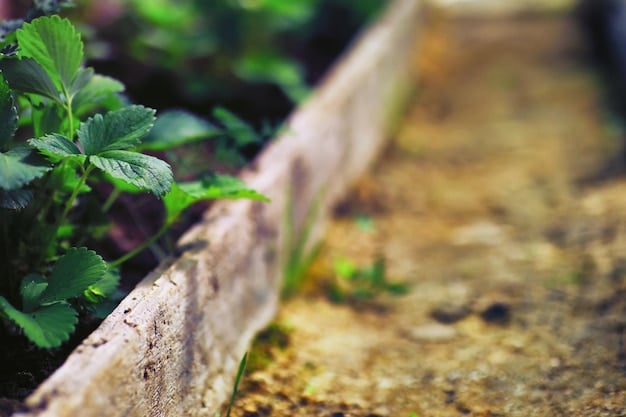
Improve soil drainage is crucial for healthy plant growth; this article provides simple, actionable solutions to address soggy garden beds and prevent waterlogged soil, ensuring optimal conditions for thriving plants.
Is your garden plagued by standing water? Does your soil feel constantly soggy? Improve soil drainage is essential for a thriving garden, and fortunately, there are several simple solutions you can implement right away.
Understanding Soil Drainage
Understanding the basics of soil drainage is the first step to solving problems in your garden. Soil drainage refers to how quickly water moves through the soil. When drainage is poor, water accumulates, leading to soggy conditions that can harm plant roots.
Several factors contribute to poor soil drainage, including soil type, compaction, and the slope of your land. Identifying these causes is crucial for choosing the right remedies.
Common Causes of Poor Soil Drainage
Poor soil drainage is often the result of a combination of factors, making it important to address the root causes for long-term success. Here’s a closer look at some of the most common culprits:
- Compacted Soil: Over time, soil can become compacted due to foot traffic, heavy machinery, or simply the weight of the soil itself. Compacted soil reduces pore space, hindering water’s ability to drain freely.
- Clay Soil: Clay particles are very small and tightly packed, resulting in poor drainage. Clay soil holds water well, but it can become waterlogged easily.
- Lack of Organic Matter: Organic matter helps to improve soil structure, creating larger pore spaces for water to drain. When soil is low in organic matter, it tends to compact and drain poorly.
- Underlying Hardpan: A hardpan is a dense, impermeable layer of soil that can prevent water from draining downwards. It can be natural or caused by repeated tilling at the same depth.
By addressing these underlying causes, you can create a healthier, better-draining environment for your plants.
In conclusion, understanding the root causes of poor drainage allows gardeners to target solutions effectively, fostering a healthier and more productive garden environment.
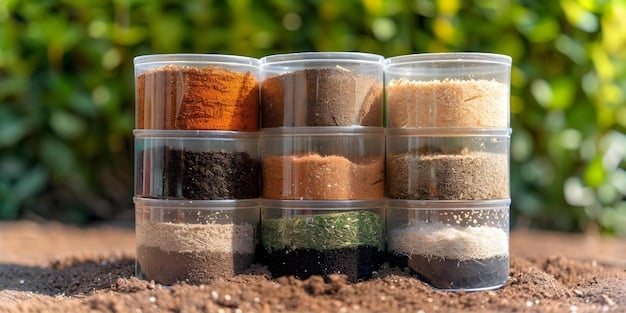
Testing Your Soil Drainage
Before you begin implementing solutions, it’s important to assess how well your soil drains. A simple soil drainage test can provide valuable insights into the severity of the problem.
This test involves digging a hole, filling it with water, and observing how quickly the water drains away. The results will help you determine the best course of action for improving drainage.
Performing a Simple Drainage Test
Testing your soil’s drainage is a straightforward process that can provide valuable information about your garden’s health. Here’s how to conduct a simple drainage test:
- Dig a Hole: Dig a hole approximately 1 foot wide and 1 foot deep in the area where you suspect drainage problems.
- Fill with Water: Fill the hole completely with water and allow it to drain. This pre-soaking helps to saturate the surrounding soil.
- Refill and Observe: Once the water has drained, refill the hole with water. Now, observe how long it takes for the water to drain completely.
- Analyze the Results: If the water drains within a few hours, your soil has good drainage. If it takes more than 24 hours, you have a drainage problem that needs to be addressed.
Interpreting the results of your drainage test will help you to understand the extent of the drainage issues present in your soil.
To summarize, performing a simple drainage test is a beneficial first step in understanding and addressing potential soil drainage problems effectively.
Amending Soil with Organic Matter
One of the most effective ways to improve soil drainage is by incorporating organic matter. Organic matter acts like a sponge, improving soil structure and creating air pockets that facilitate water movement.
Compost, well-rotted manure, and peat moss are excellent choices for amending your soil and promoting better drainage.
Best Types of Organic Matter
Choosing the right type of organic matter can significantly impact the effectiveness of your soil amendment efforts. Here are some of the best options to consider:
- Compost: Compost is decomposed organic material that is rich in nutrients and beneficial microbes. It improves soil structure, drainage, and fertility.
- Well-Rotted Manure: Manure from herbivores like cows, horses, and chickens can be an excellent source of organic matter. Ensure it is well-rotted to avoid burning plant roots and spreading pathogens.
- Peat Moss: Peat moss is a lightweight, absorbent material that helps to improve soil aeration and water retention. However, it is important to use peat moss sustainably, as its extraction can have environmental impacts.
Selecting the most appropriate organic matter based on your garden’s specific needs can lead to healthier soil and better plant growth.
In short, amending your soil with organic matter is a crucial step in creating a well-draining, fertile environment for your plants to thrive.
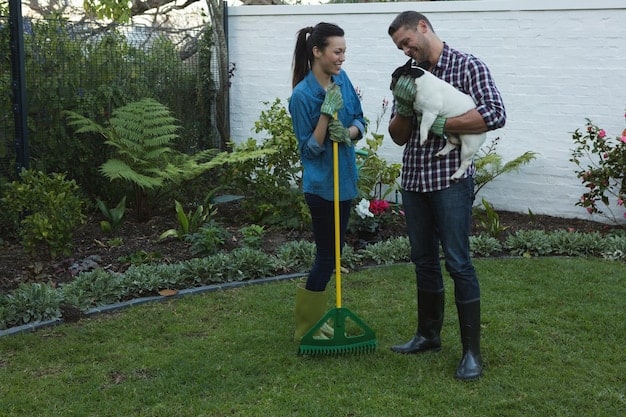
Creating Raised Garden Beds
Raised garden beds are an excellent solution for areas with persistent drainage problems. By elevating the soil, you create a well-draining environment for your plants.
Raised beds also allow you to control the soil composition, ensuring optimal conditions for root growth and nutrient uptake.
Benefits of Raised Garden Beds
Raised garden beds offer numerous advantages for gardeners, especially in areas with heavy clay or poor drainage. Here are some key benefits:
- Improved Drainage: Elevating the soil allows excess water to drain away more easily, preventing waterlogged conditions that can harm plant roots.
- Better Soil Control: Raised beds allow you to create a custom soil mix tailored to the specific needs of your plants. This is particularly useful if your native soil is of poor quality.
- Reduced Soil Compaction: By gardening in raised beds, you reduce foot traffic on the soil, minimizing compaction and maintaining good soil structure.
- Easier Access: Raised beds can make gardening more accessible for people with mobility issues, as they reduce the need to bend over or kneel.
Embracing raised garden beds can significantly improve your gardening experience, particularly in challenging environments where soil drainage is a concern.
In conclusion, raised garden beds offer a practical and effective way to overcome drainage issues, providing a controlled environment for plant growth and improved accessibility for gardeners.
Installing Drainage Systems
For more severe drainage problems, installing a drainage system may be necessary. French drains and buried drainage pipes can effectively redirect water away from your garden.
These systems involve creating channels or trenches that allow water to flow freely and prevent it from accumulating in the soil.
Types of Drainage Systems
Choosing the right drainage system depends on the specific conditions of your garden and the severity of the drainage problems. Here are two common types of drainage systems:
* French Drains: French drains consist of a trench filled with gravel and a perforated pipe. The gravel allows water to filter into the pipe, which then carries the water away from the garden.
* Buried Drainage Pipes: Buried drainage pipes are similar to French drains, but they typically involve a more extensive network of pipes to cover a larger area. These systems are often used in areas with significant drainage issues.
French drains provide a straightforward and efficient way to manage excess water, making them a popular choice for gardeners dealing with drainage issues.
In summary, while they require more effort to install, drainage systems can profoundly improve soil drainage in gardens with severe or constant waterlogging problems.
Grading and Sloping the Soil
Proper grading and sloping can help to direct water away from your garden. By ensuring that the land slopes slightly away from planting areas, you can prevent water from pooling and causing drainage problems.
This technique is particularly useful in areas with naturally flat or poorly sloped terrain.
Tips for Effective Grading and Sloping
Achieving effective grading and sloping involves careful planning and attention to detail. Here are some tips to ensure your efforts are successful:
- Assess the Existing Slope: Before making any changes, assess the existing slope of your land. Identify areas where water tends to accumulate and determine the direction in which you want the water to flow.
- Create a Gentle Slope: Aim for a gentle slope of about 2-3% away from planting areas. This is typically enough to allow water to drain without causing erosion.
- Use a Level: Use a level to ensure that the slope is consistent and even. This will help to prevent uneven drainage and water pooling.
- Consider Terracing: In sloped areas, consider terracing to create level planting areas and prevent soil erosion. Terraces can also improve drainage by slowing down the flow of water.
By following these tips, you can effectively grade and slope your soil to improve drainage and create a healthier growing environment.
In conclusion, correct grading and sloping are often overlooked aspects of improving soil drainage but can be highly effective in routing water away from sensitive garden areas.
| Key Point | Brief Description |
|---|---|
| 🌱 Organic Matter | Improves soil structure, aeration, and water drainage. |
| ⬆️ Raised Beds | Elevate soil, creating better drainage for plants. |
| 💧 Drainage Systems | Redirect excess water away from the garden. |
Why is soil drainage important?
▼
Proper soil drainage prevents roots from suffocating due to lack of oxygen, reduces the risk of root rot, and promotes overall plant health and vigorous growth.
▼
Organic matter creates air pockets in the soil, improving its structure and allowing water to drain more freely. It also helps to prevent soil compaction, which can hinder drainage.
▼
Raised garden beds provide excellent drainage by elevating the soil, allowing you to control the soil composition and preventing water from pooling around plant roots.
▼
Consider installing a drainage system if you have persistent drainage problems, such as consistently soggy soil or standing water, even after implementing other solutions.
▼
Yes, grading and sloping can significantly improve soil drainage by directing water away from planting areas, preventing water from accumulating and causing drainage issues.
Conclusion
Improving soil drainage is vital for the health and productivity of your garden. By understanding the causes of poor drainage and implementing the solutions discussed, such as amending soil with organic matter, creating raised beds, installing drainage systems, and grading the soil, you can create an optimal growing environment for your plants.

